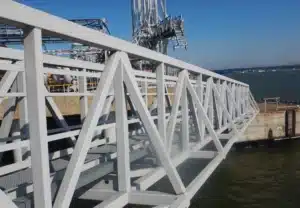Primers with purpose: The No,1 overlooked power in corrosion protection
More than a basecoat, the right primer plays a decisive role in how long a coating system can stand up to the elements.
When it comes to protecting steel structures from corrosion, the topcoat often gets the attention. It’s what people see. But what lies beneath, the primer, is doing much of the heavy work.
Primers are designed to bind the coating system to the substrate – that much is widely understood. What is less discussed is how much a primer can influence the lifespan, durability and even safety of an industrial surface.
“A good primer doesn’t just help paint stick – it actively fights corrosion,” explains Tomi Kontunen, a corrosion protection specialist at Teknos. “It’s the front line, especially in environments where failure isn’t an option.”
In heavy industry and infrastructure, exposure conditions vary widely: steel bridges exposed to marine air, support structures under chemical stress or machinery facing daily abrasion. Primers are rarely interchangeable. A zinc-rich epoxy that works on an offshore rig may be unsuitable in a warehouse setting, just as a waterborne primer for light indoor use may fail outdoors after a single winter.
And yet, many projects treat primers as generic.

When it comes to protecting steel structures from corrosion the primer is doing much of the heavy work
Primers off a silent, chemical defence
Modern corrosion-protection primers ensure good adhesion of painting system to substrate. They create dense paint film, like epoxies, or contain inhibitors that slow down the chemical reactions that lead to rust. Zinc-rich primers go further, offering sacrificial cathodic protection by corroding in place of the steel beneath.
Each of these mechanisms serves a different purpose. And each is most effective only under specific conditions, defined by humidity, salinity, temperature variation and surface preparation quality.
“We’ve seen many cases where the primer is technically sound, but it wasn’t right for the job,” Kontunen noted. “That’s where most failures begin, not in the topcoat, but at the base.”
More than chemistry
Selecting a primer is as much about process as it is about performance. How will the steel be prepared, is it shot blasted to Sa2.5 and what is the surface roughness, is it in line with the painting system total dry film thickness? Will the application take place in a controlled facility or outdoors on site? How long until the topcoat is applied? Will welding or cutting follow?
These are questions coatings manufacturers like Teknos ask when working with customers. It’s not only about product selection but about aligning materials with realities on the ground.
“Technical support is part of the system,” says Kontunen. “Because paint is not installed in ideal conditions – it’s installed in the real world.”
What’s at stake
Corrosion costs economies billions each year. It undermines infrastructure, delays production and introduces safety risks. Extending the life of a coating system by getting the primer right can reduce total maintenance costs, avoid shutdowns and preserve asset integrity.
A primer may not be visible once the job is finished. But it’s doing its work, silently, for years.
Looking closer at primers
Those responsible for protective coating specifications, engineers, asset owners, procurement leads, would do well to start their conversations below the surface. The best coatings are systems, and every system is only as strong as its foundation.
For those seeking technical guidance on selecting the right system from the start, Teknos provides material recommendations and system design tailored to project needs and environmental conditions.

